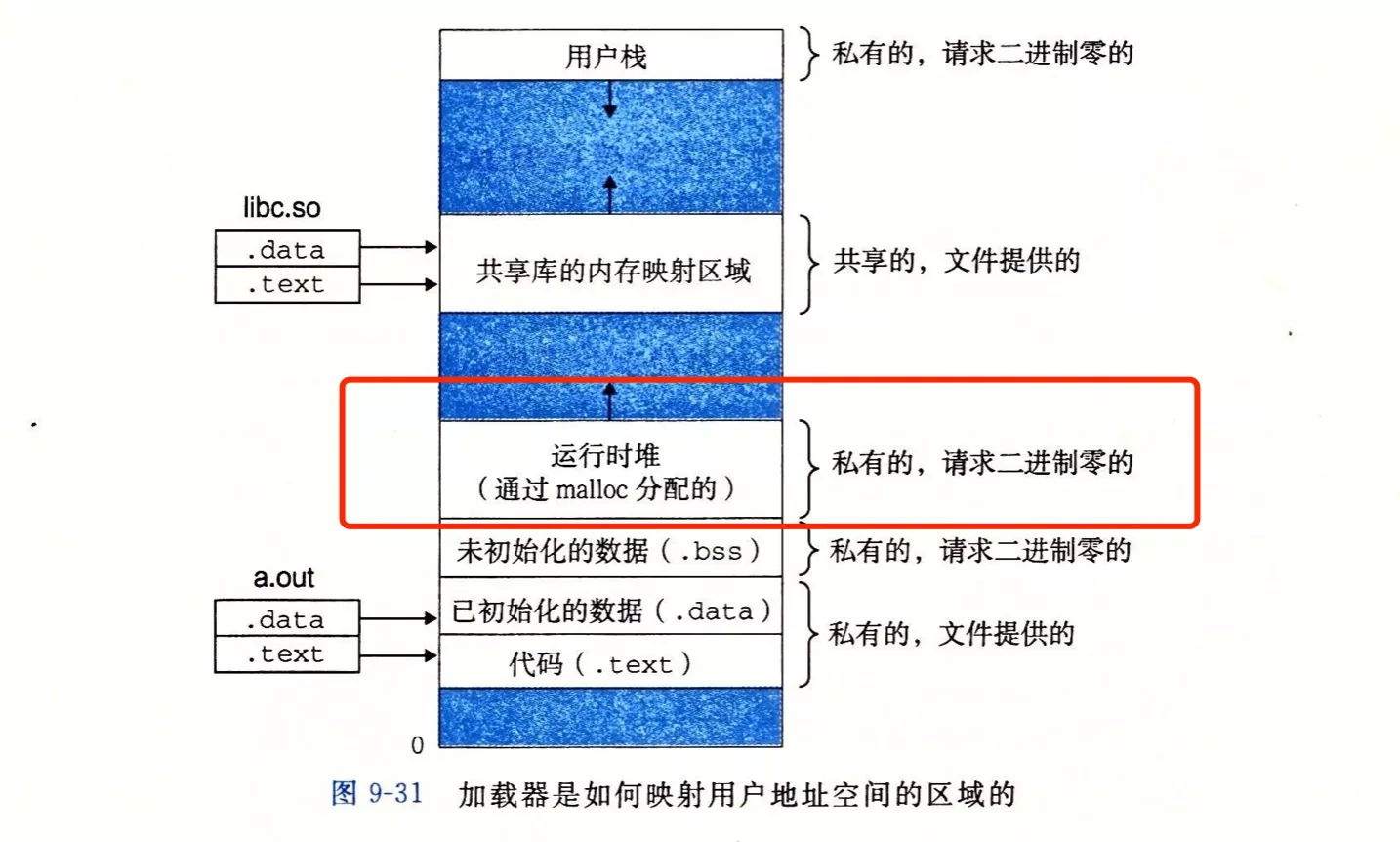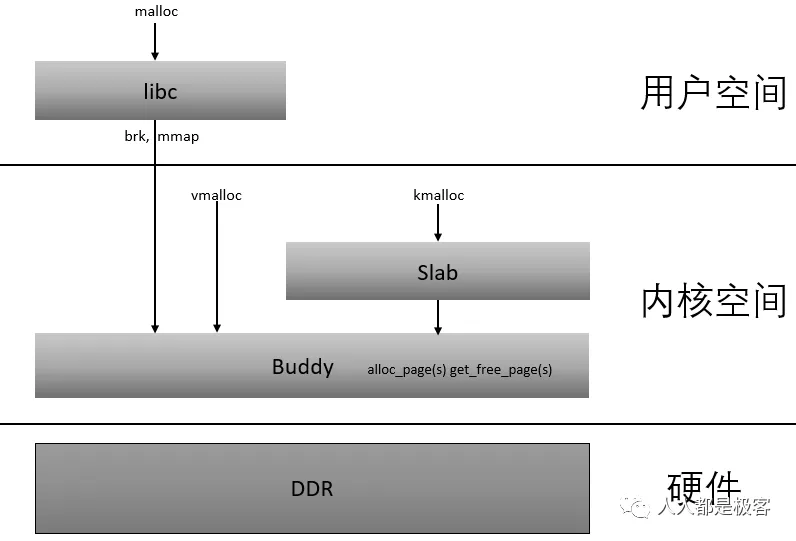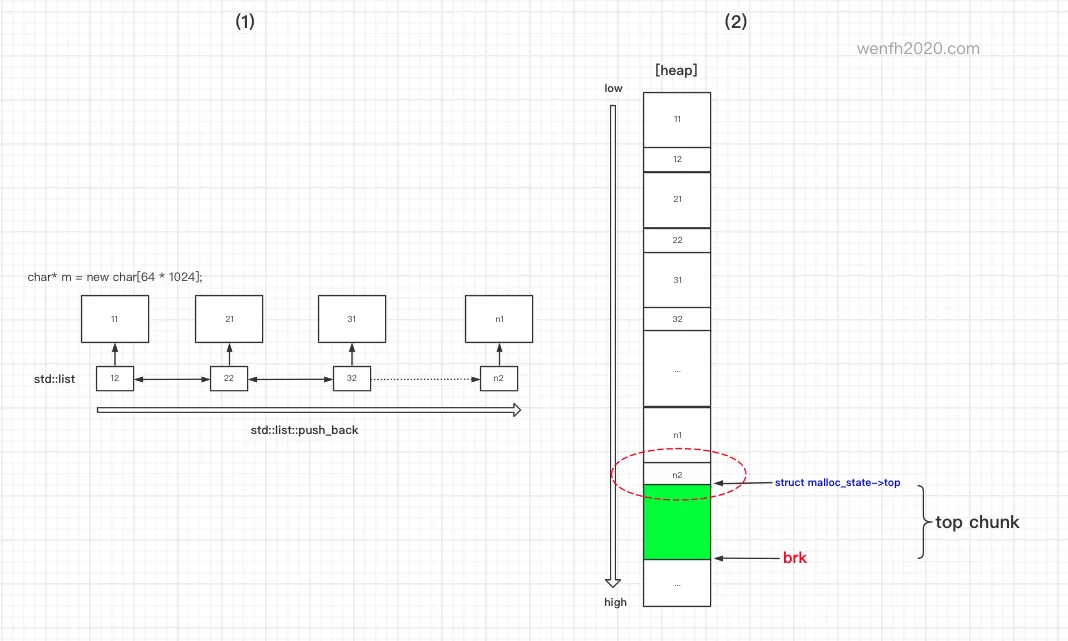最近项目增加了一个模块,在 Centos 系统压测,进程一直不释放内存。因为新增代码量不多,经过排查,发现 stl + glibc 这个经典组合竟然有问题,见鬼了!
通过调试和查阅 glibc 源码,好不容易才搞明白它 “泄漏” 的原因:内存碎片!
碎片将大块的空闲连续内存块割裂,导致空闲内存块没有达到返还系统的阈值,内存回收失败!
深层原因:glibc 内部内存池管理空闲内存的策略问题,ptmalloc2 内存池的 fast bins 快速缓存和 top chunk 内存返还系统的特点导致。
1. 现象
上测试源码看看:

1
2
3
4
5
6
7
8
9
10
11
12
13
14
15
16
17
18
19
20
21
22
23
24
25
26
27
28
29
30
31
32
/* g++ -g -std='c++11' example_pressure.cpp -o ep111 && ./ep111 10000 */
#include <string.h>
#include <unistd.h>
#include <iostream>
#include <list>
int main(int argc, char** argv) {
if (argc != 2) {
printf("./proc [count]\n");
return -1;
}
int cnt = atoi(argv[1]);
std::list<char*> free_list;
for (int i = 0; i < cnt; i++) {
char* m = new char[1024 * 64];
memset(m, 'a', 1024 * 64);
free_list.push_back(m);
}
for (auto& v : free_list) {
delete[] v;
}
for (;;) {
sleep(1);
}
return 0;
}
2. 分析
2.1. valgrind
用 valgrind 检查出来的结果,没有释放的部分应该是 free_list 没有调用 clear 导致,但显然不符合预期。
1
2
3
4
5
6
7
8
9
10
11
12
13
14
15
16
17
18
19
20
21
22
23
24
25
26
[root:.../coroutine/test_libco/libco]# valgrind --leak-check=full --show-leak-kinds=all ./ep111 20000
==20802== Memcheck, a memory error detector
==20802== Copyright (C) 2002-2017, and GNU GPL'd, by Julian Seward et al.
==20802== Using Valgrind-3.15.0 and LibVEX; rerun with -h for copyright info
==20802== Command: ./ep111 20000
...
==20802==
==20802== HEAP SUMMARY:
==20802== in use at exit: 480,000 bytes in 20,000 blocks
==20802== total heap usage: 40,000 allocs, 20,000 frees, 1,311,200,000 bytes allocated
==20802==
==20802== 480,000 bytes in 20,000 blocks are still reachable in loss record 1 of 1
==20802== at 0x4C2A593: operator new(unsigned long) (vg_replace_malloc.c:344)
==20802== by 0x401186: __gnu_cxx::new_allocator<std::_List_node<char*> >::allocate(unsigned long, void const*) (new_allocator.h:104)
==20802== by 0x4010E5: std::_List_base<char*, std::allocator<char*> >::_M_get_node() (stl_list.h:334)
==20802== by 0x401016: std::_List_node<char*>* std::list<char*, std::allocator<char*> >::_M_create_node<char* const&>(char* const&) (stl_list.h:502)
==20802== by 0x400F21: void std::list<char*, std::allocator<char*> >::_M_insert<char* const&>(std::_List_iterator<char*>, char* const&) (stl_list.h:1561)
==20802== by 0x400D93: std::list<char*, std::allocator<char*> >::push_back(char* const&) (stl_list.h:1016)
==20802== by 0x400BD8: main (example_pressure.cpp:21)
==20802==
==20802== LEAK SUMMARY:
==20802== definitely lost: 0 bytes in 0 blocks
==20802== indirectly lost: 0 bytes in 0 blocks
==20802== possibly lost: 0 bytes in 0 blocks
==20802== still reachable: 480,000 bytes in 20,000 blocks
==20802== suppressed: 0 bytes in 0 blocks
2.2. pmap
用 pmap 命令查看进程,发现 640600K 这一块 [ anon ] 内存很大,应该是这个地方“泄漏”了。

图片来源:《深入理解计算机系统》
1
2
3
4
5
6
7
8
9
10
11
12
13
14
15
16
17
18
19
20
21
22
23
24
25
26
27
28
29
30
31
32
33
34
35
# pmap -p 3321
3321: ./ep111 10000
0000000000400000 8K r-x-- ep111
0000000000601000 4K r---- ep111
0000000000602000 4K rw--- ep111
# 640600K 这里数值很大,应该是泄漏的地方了。
000000000180d000 640600K rw--- [ anon ]
00007ff2a8ce5000 1804K r-x-- libc-2.17.so
00007ff2a8ea8000 2048K ----- libc-2.17.so
00007ff2a90a8000 16K r---- libc-2.17.so
00007ff2a90ac000 8K rw--- libc-2.17.so
00007ff2a90ae000 20K rw--- [ anon ]
00007ff2a90b3000 84K r-x-- libgcc_s-4.8.5-20150702.so.1
00007ff2a90c8000 2044K ----- libgcc_s-4.8.5-20150702.so.1
00007ff2a92c7000 4K r---- libgcc_s-4.8.5-20150702.so.1
00007ff2a92c8000 4K rw--- libgcc_s-4.8.5-20150702.so.1
00007ff2a92c9000 1028K r-x-- libm-2.17.so
00007ff2a93ca000 2044K ----- libm-2.17.so
00007ff2a95c9000 4K r---- libm-2.17.so
00007ff2a95ca000 4K rw--- libm-2.17.so
00007ff2a95cb000 932K r-x-- libstdc++.so.6.0.19
00007ff2a96b4000 2044K ----- libstdc++.so.6.0.19
00007ff2a98b3000 32K r---- libstdc++.so.6.0.19
00007ff2a98bb000 8K rw--- libstdc++.so.6.0.19
00007ff2a98bd000 84K rw--- [ anon ]
00007ff2a98d2000 136K r-x-- ld-2.17.so
00007ff2a9ae0000 20K rw--- [ anon ]
00007ff2a9af2000 4K rw--- [ anon ]
00007ff2a9af3000 4K r---- ld-2.17.so
00007ff2a9af4000 4K rw--- ld-2.17.so
00007ff2a9af5000 4K rw--- [ anon ]
00007ffd62611000 132K rw--- [ stack ]
00007ffd62799000 8K r-x-- [ anon ]
ffffffffff600000 4K r-x-- [ anon ]
total 653144K
2.3. malloc 内存信息
通过查看 malloc 分配的内存信息,发现 std::list::clear 后,程序已经全部释放内存。
然而这些程序已经释放掉的内存是否已经全部返还给系统了呢?答案是:NO!glibc 缓存起来了。
system bytes = 655974400 刚好与 pmap 命令查到的堆分配内存大小一致。
【注意】C++ 的 new 也是调用 malloc 分配内存的。
- malloc_stats 打印 glibc 分配内存信息。
1
2
3
4
5
6
7
8
9
10
11
12
13
14
15
16
17
18
19
20
21
22
23
24
25
26
27
28
29
30
31
32
33
34
/* example_pressure.cpp */
...
void print_mem_info(const char* s) {
printf("------------------------\n");
printf("-- %s\n", s);
printf("------------------------\n");
malloc_stats();
}
int main(int argc, char** argv) {
...
int cnt = atoi(argv[1]);
std::list<char*> free_list;
print_mem_info("begin");
for (int i = 0; i < cnt; i++) {
char* m = new char[1024 * 64];
memset(m, 'a', 1024 * 64);
free_list.push_back(m);
}
print_mem_info("alloc blocks");
for (auto& v : free_list) {
delete[] v;
}
print_mem_info("free blocks");
free_list.clear();
print_mem_info("clear list.");
...
}
- 最后已经全部释放(free)内存,但是 glibc 仍然没有把内存归还系统。
1
2
# system bytes:glibc 向系统申请的内存大小。
# in use bytes:用户进程通过 malloc 向 glibc 申请分配的内存大小。
1
2
3
4
5
6
7
8
9
10
11
12
13
14
15
16
17
18
19
20
21
22
23
24
25
26
27
28
29
# g++ -g -std='c++11' example_pressure.cpp -o ep111 && ./ep111 10000
------------------------
-- begin
------------------------
Arena 0:
system bytes = 0
in use bytes = 0
...
------------------------
-- alloc blocks
------------------------
Arena 0:
system bytes = 655974400
in use bytes = 655840000
...
------------------------
-- free blocks
------------------------
Arena 0:
system bytes = 655974400
in use bytes = 320000
...
------------------------
-- clear list.
------------------------
Arena 0:
system bytes = 655974400
in use bytes = 0
...
3. glibc 问题分析
ptmalloc2 是目前 Linux 用户空间默认的内存分配器,源码集成在 glibc 里。
ptmalloc2 支持多线程,它为多个线程提供了多个 arena 分区(malloc_state)管理内存:主分区和非主分区(main_arena/non_main_arena)。因为本文 demo 是单线程,所以我们这里只讨论 main_arena 场景,详细请参考文档:glibc内存管理ptmalloc源代码分析.pdf。
至于 free 掉的内存 glibc 为啥没有返还给系统,通过走读和调试它的源码后,发现 malloc_state.top 这个 top chunk 对问题解决起着关键作用。
3.1. 系统内存分配流程
- ptmalloc2 主要通过
sbrk和mmap这两个函数,向内核申请内存空间。因为上述例子是单线程的,而且每次(new/malloc)申请的内存小于 128k,所以用户空间向内核申请内存通过 sbrk 而不是 mmap。

3.2. 关键内存结构
3.2.1. malloc_chunk
ptmalloc2 每次会根据需要向内核申请一大块内存空间,并将其分割成大小不等的内存块,内存块以 chunk 形式进行管理。
1
2
3
4
5
6
7
8
9
10
11
12
13
14
15
16
/*
This struct declaration is misleading (but accurate and necessary).
It declares a "view" into memory allowing access to necessary
fields at known offsets from a given base. See explanation below.
*/
struct malloc_chunk {
INTERNAL_SIZE_T prev_size; /* Size of previous chunk (if free). */
INTERNAL_SIZE_T size; /* Size in bytes, including overhead. */
struct malloc_chunk* fd; /* double links -- used only if free. */
struct malloc_chunk* bk;
/* Only used for large blocks: pointer to next larger size. */
struct malloc_chunk* fd_nextsize; /* double links -- used only if free. */
struct malloc_chunk* bk_nextsize;
};
这个结构比较特别,已分配出去的内存结构,结构是下面这样的。
1
2
3
4
5
6
7
8
9
10
11
12
chunk--> +-+-+-+-+-+-+-+-+-+-+-+-+-+-+-+-+-+-+-+-+-+-+-+-+-+-+-+-+-+-+-+-+
| Size of previous chunk, if allocated |
+-+-+-+-+-+-+-+-+-+-+-+-+-+-+-+-+-+-+-+-+-+-+-+-+-+-+-+-+-+-+-+-+
| Size of chunk, in bytes |A|M|P|
mem--> +-+-+-+-+-+-+-+-+-+-+-+-+-+-+-+-+-+-+-+-+-+-+-+-+-+-+-+-+-+-+-+-+
| User data starts here... .
. .
. (malloc_usable_size() bytes) .
. |
nextchunk--> +-+-+-+-+-+-+-+-+-+-+-+-+-+-+-+-+-+-+-+-+-+-+-+-+-+-+-+-+-+-+-+-+
| Size of chunk |
+-+-+-+-+-+-+-+-+-+-+-+-+-+-+-+-+-+-+-+-+-+-+-+-+-+-+-+-+-+-+-+-+
malloc 给用户返回内存是 mem 的地址,事实上,它前面有两个 size_t 大小的空间分别保存了:前一个 chunk 大小,当前 chunk 大小。只有在前一个 chunk 空闲时,这个 prev_size 才会有效。而 fd, bk, fd_next_size, bk_nextsize 这几个成员,只有空闲块才会用到。
3.2.2. malloc_state
可以理解为线程的内存池分区(arena),那些 free 接口释放的内存,会根据一定的策略缓存起来,或者返还系统。
因为 ptmalloc2 本来就是一个内存池,为了提高内存分配效率,避免用户态和内核态频繁进行交互,它需要通过一些策略,将部分用户释放(delete/free)的内存缓存起来,不马上返还给系统。而缓存起来的内存块,通过 fastbinsY 和 bins 这些数组维护起来,数组保存的是空闲内存块链表。
top 这个内存块指向 top chunk,它对于理解 glibc 从系统申请内存,返还内存给系统有着关键作用。
1
2
3
4
5
6
7
8
9
10
11
12
13
14
typedef struct malloc_chunk* mchunkptr;
typedef struct malloc_chunk* mfastbinptr;
struct malloc_state {
...
mfastbinptr fastbinsY[NFASTBINS];
/* Base of the topmost chunk -- not otherwise kept in a bin */
mchunkptr top;
/* Normal bins packed as described above */
mchunkptr bins[NBINS * 2 - 2];
...
};
| 成员 | 描述 |
|---|---|
| fastbinsY | 拥有 10 (NFASTBINS) 个元素的数组,用于存放每个 fast chunk 链表头指针,所以 fast bins 最多包含 10 个 fast chunk 的单向链表。 |
| top | 是一个 chunk 指针,指向分配区的 top chunk。 |
| bins | 用于存储 unstored bin,small bins 和 large bins 的 chunk 链表头,small bins 一共 62 个,large bins 一共 63 个,加起来一共 125 个 bin。而 NBINS 定义为 128,其实 bin[0] 和 bin[127] 都不存在,bin[1] 为 unsorted bin 的 chunk 链表头,所以实际只有 126 bins。 |
3.3. sbrk 系统分配回收内存
测试 demo 分配小内存,当 glibc 内存池缓存不足时,glibc 会通过 sbrk 向系统申请内存给 malloc_state.top,也就是 top chunk,从它那里划分一块出来返回给用户进程。
当 top chunk 内存达到一个回收阈值时,它才会通过 sbrk 返还内存给系统。所以说理解 malloc_state.top 是解决问题的关键。

3.3.1. 内存块长期不被回收
很多时候,通过 free 释放掉的内存块,它不是紧贴 top chunk 那一块内存,它被释放后并没有合并到 top chunk,所以 top chunk 的大小没有改变,没有达到返还系统的阈值,所以空闲内存不会被返还系统, 如上图,如果程序刚好有一个像 n2 那样的小内存块长时间不释放,那就杯具了。例如:
1
2
3
4
5
6
7
8
9
10
11
12
13
14
15
16
17
18
19
20
21
22
23
24
25
26
27
28
29
30
31
32
void print_mem_info(const char* s) {
printf("------------------------\n");
printf("-- %s\n", s);
printf("------------------------\n");
malloc_stats();
printf("------------------------\n");
}
void test() {
char *addr, *addr2;
int size = 64 * 1024;
char* mems[64 * 1024];
for (int i = 0; i < size; i++) {
addr = (char*)malloc(4 * 1024 * sizeof(char));
mems[i] = addr;
}
/* 紧贴 top chunk 的小内存块 addr2,如果一直不释放,那它前面分配的内存即使 free 掉后,
内存池依然不会将缓存返还给系统。 */
addr2 = (char*)malloc(1 * sizeof(char));
for (int i = 0; i < size; i++) {
free(mems[i]);
}
print_mem_info("stats info");
for (;;) {
sleep(1);
}
...
}
1
2
3
4
5
6
------------------------
-- stats info
------------------------
Arena 0:
system bytes = 269602816 # ptmalloc2 向系统申请的内存。
in use bytes = 32 # ptmalloc2 已经分配出去给用户使用的内存,还没释放。
3.3.2. fast bins 缓存
有时候即便回收的内存紧贴 top chunk,但是被释放的内存太小了,以至于内存池为了保证小内存的分配效率,而将其缓存起来放进 fast bins,而没有被 top chunk 合并。
例如上图图 2,就是测试 demo 图 1 的内存布局。堆内存是从低位向高位分配,但是如果 n2 内存没有被 free 掉,或者 n2 被 free 掉后,内存池为了效率,将其缓存起来了,并没有合并到 top chunk,那么即便 n2 之前的堆内存全部 free 掉了,内存池也不会将内存归还系统的。
所以对于 fast bins 这些缓存起来的小空闲内存块,需要在某一时刻对这些小空闲内存块进行处理。
正常情况下,当内存池管理的内存块不足以满足分配时,而且 top chunk 也不够空间分配了,内存池会尝试处理 fast bins 里的这些空闲小内存块,看看能否合并出足够的大空间满足分配需求。但是如果内存池里的空间一直能满足外部的分配,那么这个处理就永远不会触发。
ptmalloc2 可能早已预见了这样的场景,所以提供了 malloc_trim 这样的接口。能主动将 n2 这样的已经释放的小内存块,从 fast bins 缓存里取出来进行合并整理。这样,零散的内存碎片很可能会因为这些小内存碎片,合并成大块的连续内存,top chunk 很大概率会跟那些空闲的内存碎片连接成为一个连续的大块内存,达到返还系统的标准。
通过上述分析,我们可以知道,为啥 glibc 会出现”内存泄漏”了。那为啥 stl + glibc 搭配出现内存泄漏的概率那么高呢?stl 内部不少类都有动态内存管理,就像图 2 的 n2 这个小内存块,如果缓存起来,一直不释放,那么其它内存块即使释放,ptmalloc2 也很大几率不会将内存返还系统。
其实这不只是 stl 的问题,即便不用 stl,用户实现复杂的业务逻辑,也很可能会因为一个小内存块不释放,导致 ptmalloc2 不能将空闲内存返还系统。
这里测试 demo,std::list 节点也会向 glibc 申请很多小内存,std::list::clear 执行后,std::list 全部节点被 free 掉了,因为 std::list 每个节点才占 32 个字节 chunk(64 位系统),它们被 fast bins 缓存起来了,并没有触发 top chunk 的内存合并。所以 top chunk 的大小一直没有超过返还系统的阈值,所以 ptmalloc2 的缓存一直没有归还系统。
3.4. malloc_trim
上面已经剖析了小内存不回收,可能会影响内存池内存返还系统。如果小内存一直不被程序释放,那怎么办?malloc_trim!
我们知道,程序申请的内存是虚拟内存,系统寻址是通过虚拟地址转换为物理地址。所以我们可以保留虚拟内存,“释放物理内存”,等到程序真正使用需要的物理内存时,再通过断页的方式,重新加载。这样就可以就可以减少系统整体的物理内存使用。
详细请参考下面 malloc_trim 的源码实现:__madvise 函数的调用。
3.5. 源码分析
- 分配内存。如果内存池没有足够内存,malloc 通过 sbrk 向系统申请一块虚拟内存给 top chunk,然后再从这块内存上分配合适的内存出去。
1
2
3
4
5
6
7
8
9
10
11
12
13
14
15
16
17
18
19
20
21
22
23
24
25
26
27
28
29
30
31
32
33
34
35
36
37
38
39
40
41
42
43
44
45
46
47
48
49
50
51
52
53
54
55
56
57
58
59
60
61
62
63
64
65
66
67
68
69
70
71
72
73
74
static void* _int_malloc(mstate av, size_t bytes) {
...
use_top:
victim = av->top;
size = chunksize(victim);
/* 如果内存池没有匹配的缓存,那么从当前 top chunk 内存块划一块内存处理分配。 */
if ((unsigned long)(size) >= (unsigned long)(nb + MINSIZE)) {
remainder_size = size - nb;
remainder = chunk_at_offset(victim, nb);
av->top = remainder;
set_head(victim, nb | PREV_INUSE | (av != &main_arena ? NON_MAIN_ARENA : 0));
set_head(remainder, remainder_size | PREV_INUSE);
check_malloced_chunk(av, victim, nb);
void* p = chunk2mem(victim);
if (__builtin_expect(perturb_byte, 0))
alloc_perturb(p, bytes);
return p;
}
/* 如果上面的 top chunk 没有足够的内存分配,那么考虑将 fast chunks 缓存的小块内存进行合并,
*(在这里缓存的小内存块有可能前后都有比较大的空闲内存块,相互合并后,可能会合并出比较大的空闲空间。)
看看是否能合并出足够的空间,提供分配。 */
else if (have_fastchunks(av)) {
malloc_consolidate(av);
/* restore original bin index */
if (in_smallbin_range(nb))
idx = smallbin_index(nb);
else
idx = largebin_index(nb);
}
else {
/* 经过上面两个步骤后,如果还是没有足够的内存,只有向内核申请内存。 */
void* p = sysmalloc(nb, av);
if (p != NULL && __builtin_expect(perturb_byte, 0))
alloc_perturb(p, bytes);
return p;
}
...
}
#ifndef MORECORE
#define MORECORE sbrk
#endif
static void* sysmalloc(INTERNAL_SIZE_T nb, mstate av) {
...
if (contiguous(av))
size -= old_size;
size = (size + pagemask) & ~pagemask;
...
if (size > 0)
brk = (char*)(MORECORE(size));
...
/* Cannot merge with old top, so add its size back in */
if (contiguous(av))
size = (size + old_size + pagemask) & ~pagemask;
...
/* finally, do the allocation */
p = av->top;
size = chunksize(p);
/* 经过 sbrk 内存分配,top chunk 已经有足够的内存空间了,那么从它那里将 nb 大小的内存划分出去。 */
if ((unsigned long)(size) >= (unsigned long)(nb + MINSIZE)) {
remainder_size = size - nb;
remainder = chunk_at_offset(p, nb);
av->top = remainder;
set_head(p, nb | PREV_INUSE | (av != &main_arena ? NON_MAIN_ARENA : 0));
set_head(remainder, remainder_size | PREV_INUSE);
check_malloced_chunk(av, p, nb);
return chunk2mem(p);
}
...
}
- 释放内存。
1
2
3
4
5
6
7
8
9
10
11
12
13
14
15
16
17
18
19
20
21
22
23
24
25
26
27
28
29
30
31
32
33
34
35
36
37
38
39
40
41
42
43
44
45
46
47
48
49
50
51
52
53
54
55
56
57
58
59
60
61
62
63
#ifndef DEFAULT_MXFAST
#define DEFAULT_MXFAST (64 * SIZE_SZ / 4)
#endif
#define FASTBIN_CONSOLIDATION_THRESHOLD (65536UL)
static void _int_free(mstate av, mchunkptr p, int have_lock) {
...
/* 小内存块有可能被缓存起来,例如 std::list 32 个字节的节点。 */
if ((unsigned long)(size) <= (unsigned long)(get_max_fast()) /* DEFAULT_MXFAST */
#if TRIM_FASTBINS
/*
If TRIM_FASTBINS set, don't place chunks
bordering top into fastbins
*/
&& (chunk_at_offset(p, size) != av->top)
#endif
) {
/* 小内存块缓存到 fastbin. */
...
}
...
else if (!chunk_is_mmapped(p)) {
/* free 掉的内存,可能很大,也可能因为前后有空闲块,合并成一个大空闲块,
* top chunk 也可能达到释放的阈值,尝试收缩返还系统。 */
if ((unsigned long)(size) >= FASTBIN_CONSOLIDATION_THRESHOLD) {
if (have_fastchunks(av))
malloc_consolidate(av);
if (av == &main_arena) {
#ifndef MORECORE_CANNOT_TRIM
if ((unsigned long)(chunksize(av->top)) >= (unsigned long)(mp_.trim_threshold))
systrim(mp_.top_pad, av);
#endif
}
...
}
...
}
}
#ifndef MORECORE
#define MORECORE sbrk
#endif
static int systrim(size_t pad, mstate av) {
...
pagesz = GLRO(dl_pagesize);
top_size = chunksize(av->top);
/* 释放 top chunk 这个块超出阈值那部分(以页为单位)。 */
extra = (top_size - pad - MINSIZE - 1) & ~(pagesz - 1);
if (extra > 0) {
current_brk = (char*)(MORECORE(0));
if (current_brk == (char*)(av->top) + top_size) {
/* 以页为单位回收 top chunk 多出来的内存。 */
MORECORE(-extra);
...
}
}
...
}
- 回收空闲内存。整理合并 fast bins 缓存的小内存块;或者回收达到一定数值的空闲内存块,通过
__madvise告诉系统这些内存虽然不能从虚拟内存清除,但是可以先将其从物理内存清除,减少物理内存的使用,当虚拟内存使用到时,再通过缺页中断方式重新加载。
1
2
3
4
5
6
7
8
9
10
11
12
13
14
15
16
17
18
19
20
21
22
23
24
25
26
27
28
29
30
31
32
33
34
35
36
37
38
39
40
41
42
43
44
45
46
47
48
49
50
51
52
53
54
55
56
57
58
59
60
61
62
63
64
65
66
67
68
69
70
71
72
73
74
75
76
77
/*
------------------------------ malloc_trim ------------------------------
*/
static int mtrim(mstate av, size_t pad) {
/* 整理合并 fastbin 缓存的空闲小内存块。 */
malloc_consolidate(av);
const size_t ps = GLRO(dl_pagesize);
int psindex = bin_index(ps);
const size_t psm1 = ps - 1;
int result = 0;
for (int i = 1; i < NBINS; ++i)
if (i == 1 || i >= psindex) {
mbinptr bin = bin_at(av, i);
for (mchunkptr p = last(bin); p != bin; p = p->bk) {
INTERNAL_SIZE_T size = chunksize(p);
if (size > psm1 + sizeof(struct malloc_chunk)) {
/* See whether the chunk contains at least one unused page. */
char* paligned_mem = (char*)(((uintptr_t)p + sizeof(struct malloc_chunk) + psm1) & ~psm1);
assert((char*)chunk2mem(p) + 4 * SIZE_SZ <= paligned_mem);
assert((char*)p + size > paligned_mem);
/* This is the size we could potentially free. */
size -= paligned_mem - (char*)p;
if (size > psm1) {
#ifdef MALLOC_DEBUG
/* When debugging we simulate destroying the memory content. */
memset(paligned_mem, 0x89, size & ~psm1);
#endif
/* 回收达到一定数值的空闲内存块,将其从物理内存清除。 */
__madvise(paligned_mem, size & ~psm1, MADV_DONTNEED);
result = 1;
}
}
}
}
#ifndef MORECORE_CANNOT_TRIM
return result | (av == &main_arena ? systrim(pad, av) : 0);
#else
return result;
#endif
}
static void malloc_consolidate(mstate av) {
...
if (get_max_fast() != 0) {
clear_fastchunks(av);
unsorted_bin = unsorted_chunks(av);
maxfb = &fastbin(av, NFASTBINS - 1);
fb = &fastbin(av, 0);
do {
p = atomic_exchange_acq(fb, 0);
if (p != 0) {
do {
...
if (nextchunk != av->top) {
...
} else {
/* top chunk 有可能会因为空闲小内存的回收合并而增加,超过返还系统的阈值。 */
size += nextsize;
set_head(p, size | PREV_INUSE);
av->top = p;
}
} while ((p = nextp) != 0);
}
} while (fb++ != maxfb);
}
...
}
4. 解决方案
- 避免内存泄漏。malloc/new 出来的内存,一定要 free/delete 掉。
- 避免分阶段分配内存,后面分配的内存,长期驻留在程序不释放。
- 可以考虑定时执行 malloc_trim(0) 强制回收整理 fast bins 小空闲内存块,释放物理内存。
- 考虑使用 jemalloc 和 tcmalloc 替换 ptmalloc。
5. 参考
- 深入理解 malloc
- Glibc内存管理-ptmalloc2
- glibc内存管理ptmalloc源代码分析.pdf
- PART 1: UNDERSTANDING THE GLIBC HEAP IMPLEMENTATION(链接需要翻墙)
- PART 2: UNDERSTANDING THE GLIBC HEAP IMPLEMENTATION(链接需要翻墙)
- 一次”内存泄漏”引发的血案
- 有感于STL的内存管理
- malloc(3) — Linux manual page(链接需要翻墙)
- download glibc code
- centos7 安装debuginfo调试glibc源码
- malloc_trim(3) — Linux manual page
- CentOS 安装 debuginfo-install
- linux内存管理概论(二)
- 十问 Linux 虚拟内存管理 ( 一 )
- 十问 Linux 虚拟内存管理 ( 二 )


